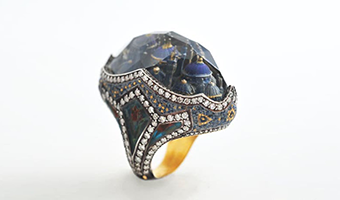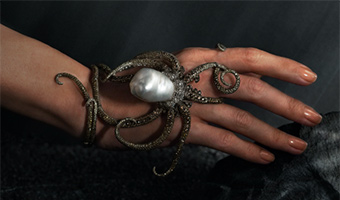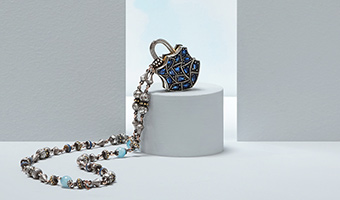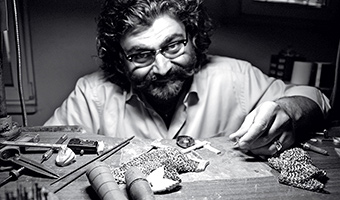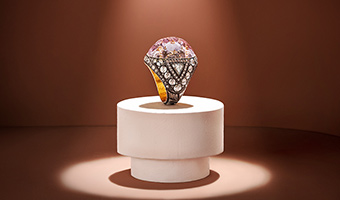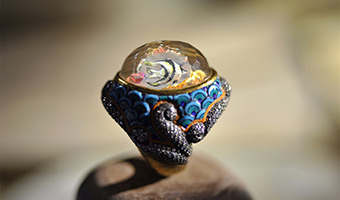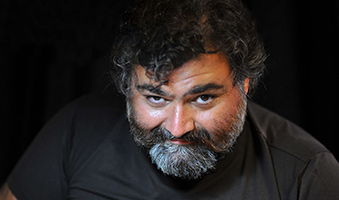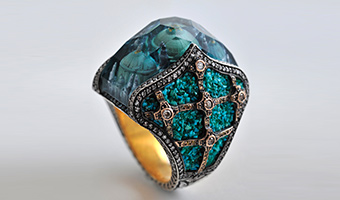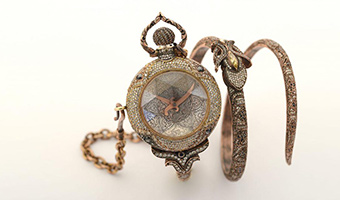An Istanbul ‘Timekeeper’ Who Believes in Taking It Slow
ISTANBUL — Known for his lavish carved-gemstone rings, the jeweler Sevan Bicakci has added watchmaking to his portfolio.
But the result probably isn’t what you’d expect: Mr. Bicakci doesn’t really worry about the ease of telling time. More important, he says, is the story that each watch tells and his painstaking journey to create it.
“With many of my watches, it’s actually very challenging to read the time because there’s so much going on: within the dial, within the design carved into the sapphire glass,” he said. “So, sometimes, you don’t see the hands.”
The focus is what he calls “slow luxury.”
“I want my watches to take people’s minds away from that feeling of always being in a rush,” he said. “If you are in a rush, just look at your cellphone.”
An example would be his ornate Potamides watch ($275,000), named for the water nymphs in Greco-Roman mythology. Made of 24-karat gold, sterling silver, diamonds and what Mr. Bicakci called “very unforgiving” sapphire crystal, it features a reverse-engraved intaglio image of a dragonfly whose wings, at certain times, obscure the minute and second hands. The watch’s gem-encircled dial is surrounded by a 4-inch cuff laden with still more diamonds and styled in the shape of outstretched wings.
“It hides the time away, that’s what I care about,” he said. “To make someone forget about time.”
Mr. Bicakci knows a thing or two about time. A Turk of Armenian descent, he took more than nine years to create an 85-piece collection, a trial-and-error process documented in a large-format book, “Sevan Bicakci: The Timekeeper,” with text by Vivienne Becker, published in December by Assouline.
As with his rings, Mr. Bicakci relied on a team that included goldsmiths, stonesetters and a sculptor to complete his designs, with their Turkish motifs like pomegranates and minarets. The movements were made at the Swatch-owned ETA factory in Switzerland.
Now 46, he dropped out of school at 12 to apprentice with a relative who was a goldsmith. He opened his own workshop by the time he was 18, and now has salesrooms in Istanbul and Miami.
For years, collectors and film producers have sought out his ornate rings. Anthony Hopkins wore Bicakci jewelry in the 2017 film “Transformers: The Last Knight,” as did Cate Blanchett in “Ocean’s Eight” last year.
And Whoopi Goldberg wore his Octopus bracelet-ring (not for sale) and his gold, silver and diamond Astrolabe watch ($280,000) to the 2016 Oscars.
It was her search for the right bit of red-carpet bling that first led her to Mr. Bicakci’s work. “I sent him an email to say: ‘Hi, my name is Whoopi. I’m an actor, I’ll be doing the Oscars and I wonder if you would ever lend me some of your jewelry. Your look is extraordinary, and yes, it’s really me,’” she said by telephone from New York, where she is the moderator of the “The View” on ABC.
“I thought he was one of the most innovative jewelers. Like Lalique or early Cartier,” added Ms. Goldberg, who is an Emmy, Grammy, Oscar and Tony winner. “I’m a huge fan, and when I grow up, one day I’m going to get one of those watches.” Editors’ Picks
Her favorite, she said, continued to be the one she first wore in 2016: “It’s gorgeous and on my skin tone, even more gorgeous. His work is just sublime.”
Mr. Bicakci had been working on his watches for several years, but his plans to expand into horology solidified after he saw a 2012 exhibition of rare, centuries-old mechanical clocks, including some made by meditative Ottoman-era dervishes, on display at Topkapi Palace in Istanbul.
“Some of these dervishes dedicated their lifetimes to the making of clocks, without caring about trade,” Mr. Bicakci said during an interview in his atelier’s offices on a back street near the Grand Bazaar. “They didn’t make them to sell. One of them made only nine clocks in his lifetime, but he excelled at it, all by himself, without an industry behind him to back him up. I liked seeing that level of commercial indifference.”
And the makers were experimental. “They weren’t educated by masters,” he said. “Some of them were true dreamers: One made a decimal watch dividing the day into 10 ‘hours’ instead of 24. I liked the imagination of someone who just takes time the proper kind of time to create, despite market conditions. These watchmakers became my heroes.”
“I’m happy I can afford to take my time,” he added. “If you stop to think what the price is going to be and who may buy it, you’ll end up not making it.”
Still, the lengthy creation process, inflation in Turkey and the country’s currency exchange crisis made pricing his watches very complicated. Prices start around $100,000 and rise significantly, depending on the materials and labor.
Thirty of the watches were shown at a small in-store event last year during Art Basel Miami Beach, but the first public exhibition of the entire collection was scheduled Feb. 15 to 17 at Watches & Wonders Miami, an annual event sponsored by the Fondation de la Haute Horlogerie and the Miami Design District.
One of his easier-to-read pieces is Gate of Heaven, which also is one of the collection’s most expensive (price upon request). It features more than 100 white diamonds and dozens of smaller black ones, ribs of rose gold that look something like a radiator grille, and a small version of Mr. Bicakci’s trademark dagger dangling from the clasp.
Another user-friendly watch is the gold, silver and diamond Loves Me, Loves Me Not ($160,000). The dial has an acrylic painting of 12 daisies, with petals that increase in number to match the hour.
One of the more macabre — and a favorite of Mr. Bicakci’s — is the Full Moon watch ($240,000) with its reverse-engraved intaglio of a skull and bones hovering over a graveyard. The Medusa ($170,000) shows her disembodied head encircled by fanged snakes while the Arachne ($240,000) features black diamonds and a reverse-engraved intaglio of a spider.
But the designs aren’t meant to be frightening, Mr. Bicakci said.
“The spider, for example, is a holy creature according to Islam,” he said. “Legend holds that spiders helped the Prophet Muhammad to hide in a cave by spinning a web across the opening so his enemies thought there was no one inside.”
Never forgetting his Istanbul roots, Mr. Bicakci also made the Conqueror, featuring dozens of diamonds, a painting on gold leaf of minarets and a portrait of the 15th-century Ottoman leader Sultan Mehmet II reverse-engraved on the underside of the sapphire crystal.
Was the jeweler confident he could make the transition to watches?
“I was very encouraged by what I had seen in Topkapi Palace,” Mr. Bicakci said. “Unlike the dervishes, I have bills to pay but already having experience in jewelry reassured me that I had the necessary resources and could have fun jumping into another kind of risky business.”

